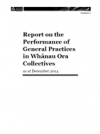This report focuses on the performance of general practices in Whānau Ora collectives – using results from the software package HealthStat, which collects an anonymous summary of patient health information from general practices in Whānau Ora collectives. Although not all collectives include general practice providers, the data collected for this report can help highlight any changes in performance over time for health providers in the collectives. The report includes results for key HealthStat indicators identified by the Ministry of Health, Te Puni Kōkiri, and Tumu Whakarae (DHB Māori Managers) as strongly associated with morbidity and mortality for Māori. The Ministry publishes these performance reports on a quarterly basis
Methodology
The Ministry of Health formed the Whānau Ora sample, comprising a selection of Māori and Pacific practices belonging to Whānau Ora collectives, by drawing on existing agreements with Māori provider practices, and then recruiting seven Pacific provider practices also as part of Whānau Ora collectives.
The national sample was selected from a list of all practices providing general primary care services that use Med-Tech (patient management software). The sampling methodology was designed to deliver a geographically representative sample of 100 practices. The overall response rate was 84 percent. The response rate from low-decile high Māori and Pacific population practices that appeared in the random sample was 100 percent; therefore, the national sample is slightly biased in favour of these populations. Also, because the national sample is randomly selected, practices may belong to both samples.
The number of practices in each sample is subject to change because of practice closures and mergers. The number of practices in the national sample is maintained near 100, while the focus of the Whānau Ora sample is to reflect the populations served in the Whānau Ora initiative.
Key Results
General practices in the Whānau Ora sample showed improving performances across a number of indicators in the year ended 30 June 2014. For the first time the Whānau Ora sample has performed as well as the national sample in the mammography for high needs indicator. This has helped make these results the most successful since results were first published in September 2012.
The improvements include:
- increased achievement against the ‘Cardiovascular disease (CVD) risk recorded’ indicator: up 18.3 percent (66.1% to 84.3%)
- increased achievement against the ‘Smoking cessation advice’ indicator: up 13.8 percent (69.1% to 82.9%)
- increased achievement against the ‘Diabetes patient review’ indicator: up 8.6 percent (70.7% to 79.3%)
Compared to the national sample, the Whānau Ora sample performed well in the following indicators:
- CVD risk recorded,
- diabetes patient review,
- smoking cessation advice,
- mammography for high needs,
- flu vaccination 65+,
- three of the four percentage of enrolled patients with prescriptions for conditions and diagnosis indicators (asthma, depression, and diabetes),
- mean fee charged,
- and medium BMI.
The Whānau Ora sample did not perform as well in the following indicators:
- diabetes management,
- cervical smear recorded,
- percentage of enrolled patients with prescriptions for ischaemic heart disease (IHD) and diagnosis indicator,
- and mental health.
The ‘Mental Health’ indicator is lower for the Whānau Ora sample than the national sample. However the growth in the indicator in both samples is positive as it indicates that practices are better identifying those patients who have need of mental health services.
Good gains have been made against the ‘Cervical smear recorded’ indicator (up 4%) although the results remain lower than the national sample.
Overall, the Whānau Ora sample results are positive, particularly given the fact that 60.1% of patients enrolled inpractices in the Whānau Ora sample are high health needs patients (Māori, Pacific and/or people living in areas of high socioeconomic deprivation). By comparison only 25.5% of the population enrolled in practices in the national sample have high health needs.
The trends seen in the Whānau Ora sample results cannot be directly attributed to any one particular programme or initiative; they are indicative of positive changes to service delivery as a whole.

